Shoot macro out of the hip – the Photar box
Posted by janvangelderen on June 6, 2006
Ice with the Photar 80 mm.
This is a lighthearted story about a serious subject. How to shoot out of the hip excellent macro. Forget everything you ever learned about macro photographing, leave tripod and flash at home and feel free. Shoot as much as you want for you are digital and on a certain moment one picture of every two is sharp, great, exellent.
Transfer your most expensive digital reflex in a box. Put a most excellent macro-objective on it. Fix it. Make sure you can not focus, transfer your camera into a fixed focus box-camera.
Now to know for what magnifications your macro-lens is build. Macro-lenses are awfully good for the magnifications they are built for and perform lousy if they are used outside their limits. But this is sometimes only an academic question. For the Leitz Photar 80 mm/5.6 in use macrolenses.de tells me that the limits are between 1 and 6.3x, that will say a millimetre in reality has to be 1 millimeter till 6.3 millimetre on the screen. However this lens performs satisfactory with an enlargement of about x8 (a millimetre is the eight of a millimetre. That gives a camera to subject distance of 60 cm. The pictures included in this article are shot on a distance of about 30 cm, that delivers a enlargement of x4 and I think they are most satisfactory. On prints of size A3 you can trace the finest details. 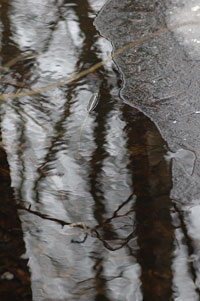
Now the advantages. The distance camera – subject of about 30 cm is easy to learn. After a few hours of practice I was able to point my camera to the subject and only very few going forward of backward was needed to get the subject in focus. Most time I don't have to shift my feet. I left the objective wide open, F 5,6, to make the shortest shutter speed. Feet out of each other, elbows in the sides, hold year breath… shoot easy and nice.
Pushing the boundaries further I added 8 centimeter of extension tube which gives with the 80 mm lens an enlargement of x1 on the screen. That is 16 cm of space between lens and sensor plane. Between lens and subject I hold a good twenty centimeter space, which is enough to allow light on the subject without my own shadow in it. The image quality increases, but was already exellent. Alas the shutter speed becomes a lot longer. (See further for calculating all those things).
Melting ice on a stream. Field of view 17 cm high.

Parsnips with Tessar 240 mm.
Diaphragm
Shooting goes with wide open diaphragm. The Photar, being one of the best macro-lenses ever made, does not show a lesser image quality compared to diaphragm setting of 6,3 or 8. The increase in sharpness into depth with smaller diaphragms is neglectable with this high magnification ratio.
So why not use a lens without any diaphragm at all? They are cheap. I found myself a Carl Zeiss S-Tessar 5.6/240 mm. This one comes from a big photocopier and made 1 : 1 colour copies format A 3. Within these limits sharpness and coloration are excellent and a square stays a square.
Even on a bellows of 200 mm I can't use these lens to obtain 1 : 1 pictures, but never the less the results at x7 to x12 wonderful. For the fact that the constructors have layed all aberration outside the reach of 1 times, you notice with this simple build lens – a triplet with a coated frontlens – in the unsharp back- and foreground a kind of radiant shine. Beautiful. This is the lens I go to use for making shots of big insects like butterflies. With the bellow at longest in full sunshine I get shutterspeeds of 1/300 with 200 ASA. (Remember shutterspeed is not determined by lenght of the bellow but by how big your image comes on the screen.) By this long focus lens it helps that the bellows itself gives rise to a firm grip on the camera.
Shoot your macros from the hip and feel liberated. Along a French roadside there flowered and seeded hundreds of parsnips and I shot thirty in an hour, my tripod weeping in the basement.
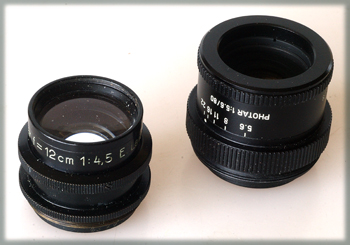
'Official' macrolenses. Left 120 mm Summar and right Photar 80 mm. Both are Leitz.
A Zeiss Tessar from a copy machine.


Not clear for what this Minolta Rokkarlens was designed. But is an exellent macrolens for magnifications between x11and x17. No irisdiaphragm.
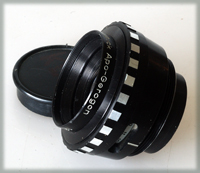
Apochromatic reprolenses (this an old 150mm/9 Apo Geronar) are doing veru well. So do apolenses for enlarging.
Choice of lenses
Having concluded that for this kind of photography a diaphragm is not needed on an objective there is suddenly an enormous amount of good macro-lenses available. They come from copiers, enlargers, reading apparatus, x ray machines. Sometimes they are nameless, but they all are from good breed.
You mount them on a T-mount or an extension tube with Araldite. Some are very heavy, so you carry the camera by its lens.
A good source of good macro-lenses are enlarging apparatus from the analogue area. Good lenses are Rodenstock Apogaron, Schneider-Kreuznach Componon-S, Nikor EL, Leitz Focotar, etc.
T-Mounts do big money on the Internet, but are cheap from the Surplus Shed, Indian made.
From X-ray and other medical equipment come very nice and extremely bright macro-lenses such as De Oude Delft Rxair and Rodenstock XR-Heligon with apertures of 1,1 and the like. If mounted on their focal length plus something before your camera they give rise to an extreme form of macro photography with pictures in which a very limited band of the picture is total sharp and outside that band everything is most unsharp. Not the instrument to make all your pictures with but sometimes in some places with some subjects the results are stunning.
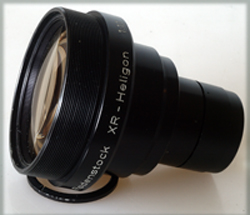
Exeptional light (F 1.1) in this 75 mm Heliogon XR.
The official lenses
Nothing against using a official lens for stark macro as Luminar (Zeiss), Photar (Leitz), Nikon Micro etc. with RMS thread for the shorter focus-lengths and screw or whatever for the longer. If you have to buy those I would strongly advise to buy a much cheaper non official macro. For Photars and Luminars the second hand prices are sky high and even ridiculous in the case of the Luminars which are not the best you can get for your money. Yashica, Minolta, Pentax, Canon among others built very nice macro lenses.
Mount your lens at the distance of two times its focal length from the sensor-plane and you get pictures in a ratio of 1 : 1. That looks wonderful but you need a lot of exercise to obtain in focus pictures. The box is for say half life size and smaller. That keeps the distance to the subject comfortable (at life size only something like 8 cm) the shutter-speeds acceptable. Remember, the more you enlarge the longer your shutter-speeds has to be. I try to use speeds of 1/500. And of course you can use a flash. But that gives less freedom and that is we wanted with the box. Besides that shooting macro with a ringflash or a single flash does not give the nicest of pictures and I load black backgrounds.
Camera extension
The principle of the camera extension is simple. You can shoot a subject of 36 mm broad lifesize on film with an 36 mm camera. And if you use a camera with a sensor it will be a smaller subject. We already know that distance lens to film plane has to be double the focal lenght of the objective for shooting life size. Use the following formula to calculate distance lens to filmplane at a given enlargement.
Symbols Definitions Examples
m Image magnification needed x 0,1
F Focal length of lens used 240 mm
E Camera extension ? (to be calculated)
Formula E=(m x F) + F
E=(0,1 x 240) + 240
E=264 mm
On the Nikon bellows I can just make this distance with the aid of some extension tubes.
What if I use my Photar 80 mm and want to shoot a ratio of x1?
E=(m x F) + F=(0,1 x 80) + 80= 88 mm.
Plenty of reserve so we go to ratio 0,7.
E=(m x F) + F=(0,7 x 80) + 80= 136 mm
Calculating the exposure
If your camera is capable to expose well with non coupled lenses, fine. But the rest of us has to determine exposure in the old fashioned way. First determine what the exposure would be on infinite. Do that with handheld exposure meter. That is what the engravings on the lens tell you: the relative opening of your lens is 2.8 or whatever if the lens is focused on infinity.
But on moving your lens farther from the filmplane the relative aperture changes. There is falling less light on the film or sensor.
Formula
Symbols Definition Example
I Indicated f-number as
Engraved on the lens mount f 11
m Image magnification 1x
1 A constant 1
EA Effective aperture ?
Formula
EA=1 x (m+1)
EA=11 x (1 + 1)
EA=f 22
So if you has to shoot with 1/200 with your lens set for infinite, you now make 1/100. You can work out the relative aperture for given distances.
NOTES
Correction
We are satisfied with the image quality delivered by the S-Tessar 240 mm and the Photar 80 mm in use although we know we use those lenses for magnifications for which they are not calculated. The explanation for that may be that those lenses are designed for far bigger negative formats as the sensor of my Nikon D70. The Photar for instance for a 9 x 12 cm camera, but I have seen stunning results on 18 x 24. On the Nikon you use only the center of the objective.
Go to the site macrolenses.de if you want to know for what magnification your macro-lens is designed.
Or test your lens by picturing a journal with different magnifications and for each magnification different f values. Use strong side light (flash) to make the slightest details visible.
T-Mounts
T-mounts has on one side a screw of M 42 and on the other side a bayonet. I bought mine at www.surplusshed.com. They were new (India) and most reasonable priced. They stock T-mounts for Canon, Pentax, Minolta and Nikon, Jun 2006.
Being there nose through their catalogue.
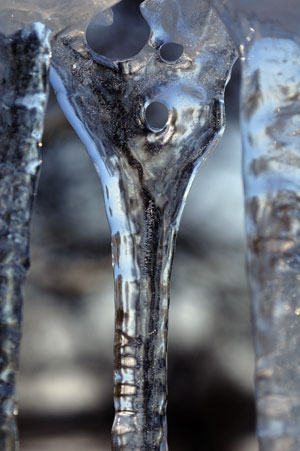


LastEnriqueta said
I have noticed you don’t monetize your website, don’t waste your
traffic, you can earn additional cash every month because you’ve got hi quality content.
If you want to know how to make extra bucks, search for: Mertiso’s
tips best adsense alternative
BestKory said
I have noticed you don’t monetize your blog, don’t
waste your traffic, you can earn extra bucks every month because you’ve got hi quality
content. If you want to know how to make extra money,
search for: Ercannou’s essential adsense alternative
BestSamara said
I have noticed you don’t monetize your website, don’t waste your traffic, you can earn extra bucks every month.
You can use the best adsense alternative for
any type of website (they approve all websites), for more info simply search in gooogle: boorfe’s tips monetize your website